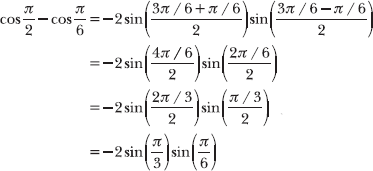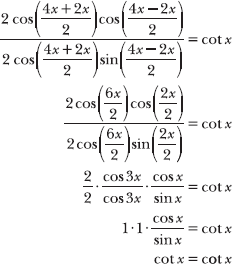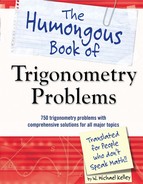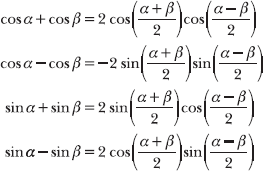Sum-to-Product Identities
Do the opposite of the last section
8.32 List the sum-to-product formulas that correspond with each of the following four sums: cos α + cos β, cos α – cos β, sin α + sin β, sin α – sin β.
The sum-to-product formulas, like the product-to-sum formulas discussed in Problems 8.28–8.31, are not typically applied to simplify an expression. Rather, they are used exclusively to express a sum or difference as a product.
The sum-to-product formulas only apply when you are adding or subtracting two cosines or two sines. In other words, there IS a formula for cos x + cos y, but there ISN’T a formula for cos x + sin y.
8.33 Demonstrate that the following expression is equivalent to the corresponding sum-to-product formula: ![]()
Begin by evaluating the given expression; its angles belong to the standard trigonometric unit circle.

Now apply a sum-to-product formula to rewrite the expression as a product.

To combine π/2 and π/6, you must express π/2 in terms of the least common denominator: π/2 = 3π/6.


The expression now contains angles that appear on the standard unit circle. Evaluate the angles and simplify the expression.

The original sum and the corresponding product have the same value: ![]() .
.
8.34 Calculate the exact value of sin 105° + sin 15° without using a calculator or trigonometric table.
Apply the sum-to-product formula for sin α + sin β, such that α = 105° and β = 15°.

If you are accustomed to radian measures, note that 60° = π/3 and 45° = π/4.

8.35 Verify the statement: ![]() .
.
Apply sum-to-product formulas to expand the numerator and denominator of the fraction.

The final statement (cot x = cot x) is true, so the original statement is verified.

